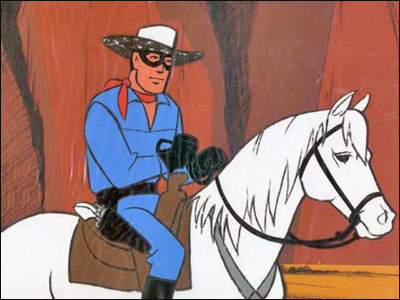
Given how many hours of how many cable channels are given over to rerunning old TV cartoons (about half of them, Scooby Doo), it's interesting how many good-to-great shows of the past are unavailable. One, which is almost forgotten, is the 1966 Lone Ranger cartoon series produced for CBS by Herb Klynn's Format Films. Format produced a number of shows in the sixties before being shoved aside by the Hanna-Barbera juggernaut. The Lone Ranger probably hastened their fall. It was not considered a success, a fact the industry attributed to its unique graphics. The artwork, done mainly by artists who'd worked on cartoonier cartoons, was very stylized and simple. The major sources of design inspiration were Roy Crane, who did the Captain Easy and Buz Sawyer newspaper strips, and Jesse Marsh, who drew the Tarzan comic books. Both of those men illustrated adventure tales in broad, simple terms that some found stunningly effective but others dismissed as childish. The artists at Format Films simplified the Crane/Marsh approach further for animation and also tried something else that was then largely unprecedented in TV animation: Large black areas.
As I said, the show failed. A good argument can be made that it would have failed no matter how it had been drawn. It had a bad time slot and the Lone Ranger was never particularly popular with kids of that generation. Moreover, by 1966, westerns on TV were on their way out and there was never any interest in animated cowboys, before or since. (A 1980 Lone Ranger show animated by Filmation didn't click, either.) Still, somehow, the graphics "took the fall" on the '66 show and thereafter, anyone attempting an animated adventure show went for a less cartoony style and often removed black from the palette used by the cel painters. The 1992 Batman: The Animated Series may have been the first show to reverse the trend. In light of its success, it might be time to haul the '66 Lone Ranger cartoons out of some vault.
For more info on the Lone Ranger's history in animation, check out Jackson King's overview over at Jim Hill Media. It's what got me thinking about the show again and prompted me to write this.